An Analysis of Training Impact on Employee Motivation and Satisfaction
VerifiedAdded on 2023/01/13
|38
|10292
|36
Report
AI Summary
This research report investigates the impact of training on employee motivation and job satisfaction, focusing on the case of Tesco. The study explores how training programs enhance employee skills, job satisfaction, and overall organizational performance. The report includes a proposal outlining the research aims, objectives, and questions, followed by a detailed literature review examining the effects of training on staff performance, job satisfaction, and employee motivation. The methodology section describes the research approach, and the data analysis and discussion chapters present the findings. The conclusion and recommendations section provides insights into the implications of the research, limitations, and suggestions for future studies. The report emphasizes the importance of training for improving employee engagement, productivity, and the creation of a supportive workplace. It also highlights the role of training in enhancing customer satisfaction and organizational competitiveness.

AN ANALYSIS OF THE
IMPACT OF TRAINING
IMPACT OF TRAINING
Paraphrase This Document
Need a fresh take? Get an instant paraphrase of this document with our AI Paraphraser

Abstract
The research report is based on the effect of the training on the motivation and the job
satisfaction of an employee in the company. The study stated an importance of the training and
development in keeping the employees or the workers motivated within the organization in order
to achieve higher productivity and sales. Training acts as the main practice that company adopts
for the purpose of enhancing the skills and abilities of an employees.
The research report is based on the effect of the training on the motivation and the job
satisfaction of an employee in the company. The study stated an importance of the training and
development in keeping the employees or the workers motivated within the organization in order
to achieve higher productivity and sales. Training acts as the main practice that company adopts
for the purpose of enhancing the skills and abilities of an employees.

Acknowledgement
I would like to show my gratitude to my supervisors and the colleagues for guiding me in
making this the project more meaningful and presentable. I am thankful to my family and the
friends who had supported and helped in making this research study.
I would like to show my gratitude to my supervisors and the colleagues for guiding me in
making this the project more meaningful and presentable. I am thankful to my family and the
friends who had supported and helped in making this research study.
⊘ This is a preview!⊘
Do you want full access?
Subscribe today to unlock all pages.

Trusted by 1+ million students worldwide
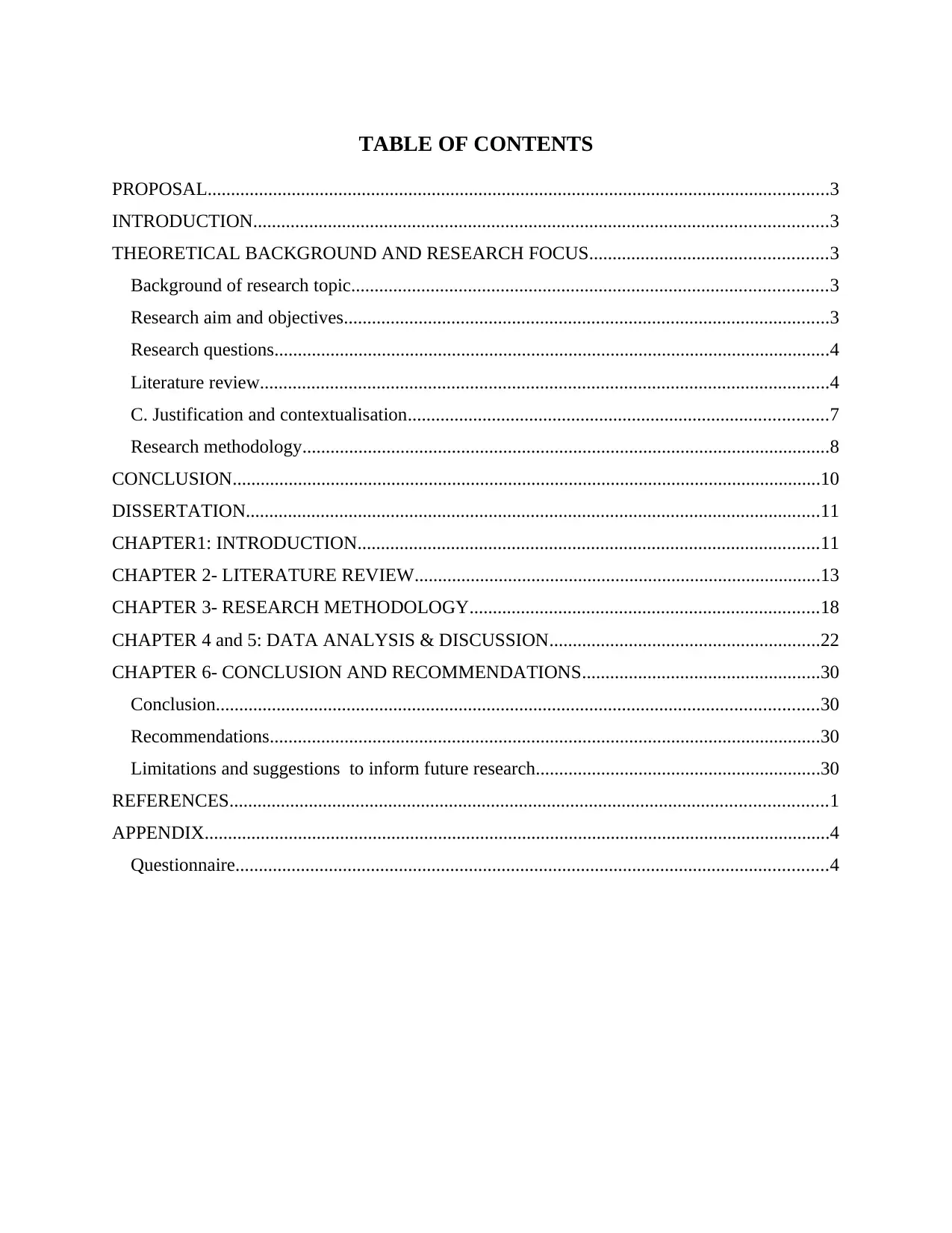
TABLE OF CONTENTS
PROPOSAL.....................................................................................................................................3
INTRODUCTION...........................................................................................................................3
THEORETICAL BACKGROUND AND RESEARCH FOCUS...................................................3
Background of research topic......................................................................................................3
Research aim and objectives........................................................................................................3
Research questions.......................................................................................................................4
Literature review..........................................................................................................................4
C. Justification and contextualisation..........................................................................................7
Research methodology.................................................................................................................8
CONCLUSION..............................................................................................................................10
DISSERTATION...........................................................................................................................11
CHAPTER1: INTRODUCTION...................................................................................................11
CHAPTER 2- LITERATURE REVIEW.......................................................................................13
CHAPTER 3- RESEARCH METHODOLOGY...........................................................................18
CHAPTER 4 and 5: DATA ANALYSIS & DISCUSSION..........................................................22
CHAPTER 6- CONCLUSION AND RECOMMENDATIONS...................................................30
Conclusion.................................................................................................................................30
Recommendations......................................................................................................................30
Limitations and suggestions to inform future research.............................................................30
REFERENCES................................................................................................................................1
APPENDIX......................................................................................................................................4
Questionnaire...............................................................................................................................4
PROPOSAL.....................................................................................................................................3
INTRODUCTION...........................................................................................................................3
THEORETICAL BACKGROUND AND RESEARCH FOCUS...................................................3
Background of research topic......................................................................................................3
Research aim and objectives........................................................................................................3
Research questions.......................................................................................................................4
Literature review..........................................................................................................................4
C. Justification and contextualisation..........................................................................................7
Research methodology.................................................................................................................8
CONCLUSION..............................................................................................................................10
DISSERTATION...........................................................................................................................11
CHAPTER1: INTRODUCTION...................................................................................................11
CHAPTER 2- LITERATURE REVIEW.......................................................................................13
CHAPTER 3- RESEARCH METHODOLOGY...........................................................................18
CHAPTER 4 and 5: DATA ANALYSIS & DISCUSSION..........................................................22
CHAPTER 6- CONCLUSION AND RECOMMENDATIONS...................................................30
Conclusion.................................................................................................................................30
Recommendations......................................................................................................................30
Limitations and suggestions to inform future research.............................................................30
REFERENCES................................................................................................................................1
APPENDIX......................................................................................................................................4
Questionnaire...............................................................................................................................4
Paraphrase This Document
Need a fresh take? Get an instant paraphrase of this document with our AI Paraphraser
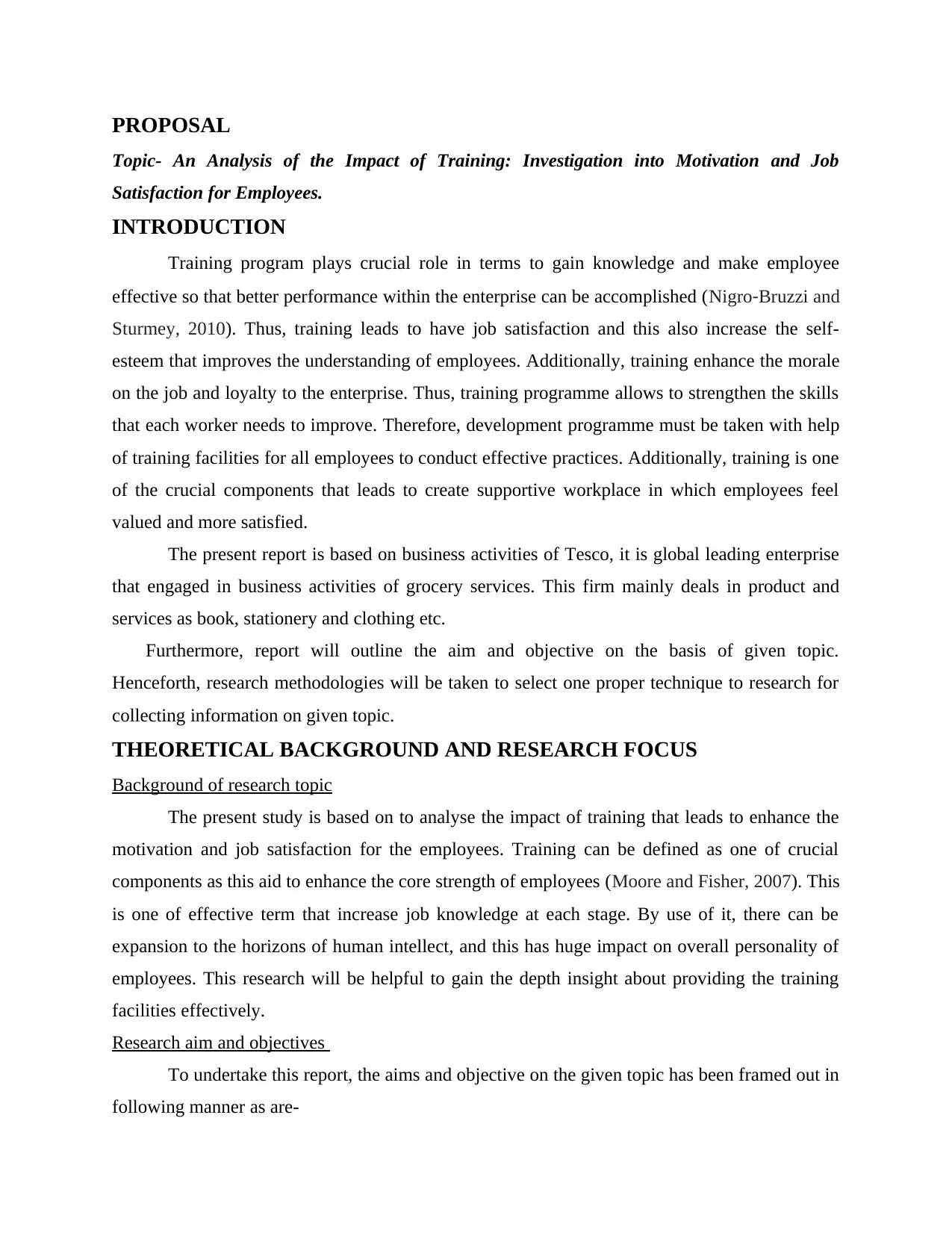
PROPOSAL
Topic- An Analysis of the Impact of Training: Investigation into Motivation and Job
Satisfaction for Employees.
INTRODUCTION
Training program plays crucial role in terms to gain knowledge and make employee
effective so that better performance within the enterprise can be accomplished (Nigro‐Bruzzi and
Sturmey, 2010). Thus, training leads to have job satisfaction and this also increase the self-
esteem that improves the understanding of employees. Additionally, training enhance the morale
on the job and loyalty to the enterprise. Thus, training programme allows to strengthen the skills
that each worker needs to improve. Therefore, development programme must be taken with help
of training facilities for all employees to conduct effective practices. Additionally, training is one
of the crucial components that leads to create supportive workplace in which employees feel
valued and more satisfied.
The present report is based on business activities of Tesco, it is global leading enterprise
that engaged in business activities of grocery services. This firm mainly deals in product and
services as book, stationery and clothing etc.
Furthermore, report will outline the aim and objective on the basis of given topic.
Henceforth, research methodologies will be taken to select one proper technique to research for
collecting information on given topic.
THEORETICAL BACKGROUND AND RESEARCH FOCUS
Background of research topic
The present study is based on to analyse the impact of training that leads to enhance the
motivation and job satisfaction for the employees. Training can be defined as one of crucial
components as this aid to enhance the core strength of employees (Moore and Fisher, 2007). This
is one of effective term that increase job knowledge at each stage. By use of it, there can be
expansion to the horizons of human intellect, and this has huge impact on overall personality of
employees. This research will be helpful to gain the depth insight about providing the training
facilities effectively.
Research aim and objectives
To undertake this report, the aims and objective on the given topic has been framed out in
following manner as are-
Topic- An Analysis of the Impact of Training: Investigation into Motivation and Job
Satisfaction for Employees.
INTRODUCTION
Training program plays crucial role in terms to gain knowledge and make employee
effective so that better performance within the enterprise can be accomplished (Nigro‐Bruzzi and
Sturmey, 2010). Thus, training leads to have job satisfaction and this also increase the self-
esteem that improves the understanding of employees. Additionally, training enhance the morale
on the job and loyalty to the enterprise. Thus, training programme allows to strengthen the skills
that each worker needs to improve. Therefore, development programme must be taken with help
of training facilities for all employees to conduct effective practices. Additionally, training is one
of the crucial components that leads to create supportive workplace in which employees feel
valued and more satisfied.
The present report is based on business activities of Tesco, it is global leading enterprise
that engaged in business activities of grocery services. This firm mainly deals in product and
services as book, stationery and clothing etc.
Furthermore, report will outline the aim and objective on the basis of given topic.
Henceforth, research methodologies will be taken to select one proper technique to research for
collecting information on given topic.
THEORETICAL BACKGROUND AND RESEARCH FOCUS
Background of research topic
The present study is based on to analyse the impact of training that leads to enhance the
motivation and job satisfaction for the employees. Training can be defined as one of crucial
components as this aid to enhance the core strength of employees (Moore and Fisher, 2007). This
is one of effective term that increase job knowledge at each stage. By use of it, there can be
expansion to the horizons of human intellect, and this has huge impact on overall personality of
employees. This research will be helpful to gain the depth insight about providing the training
facilities effectively.
Research aim and objectives
To undertake this report, the aims and objective on the given topic has been framed out in
following manner as are-
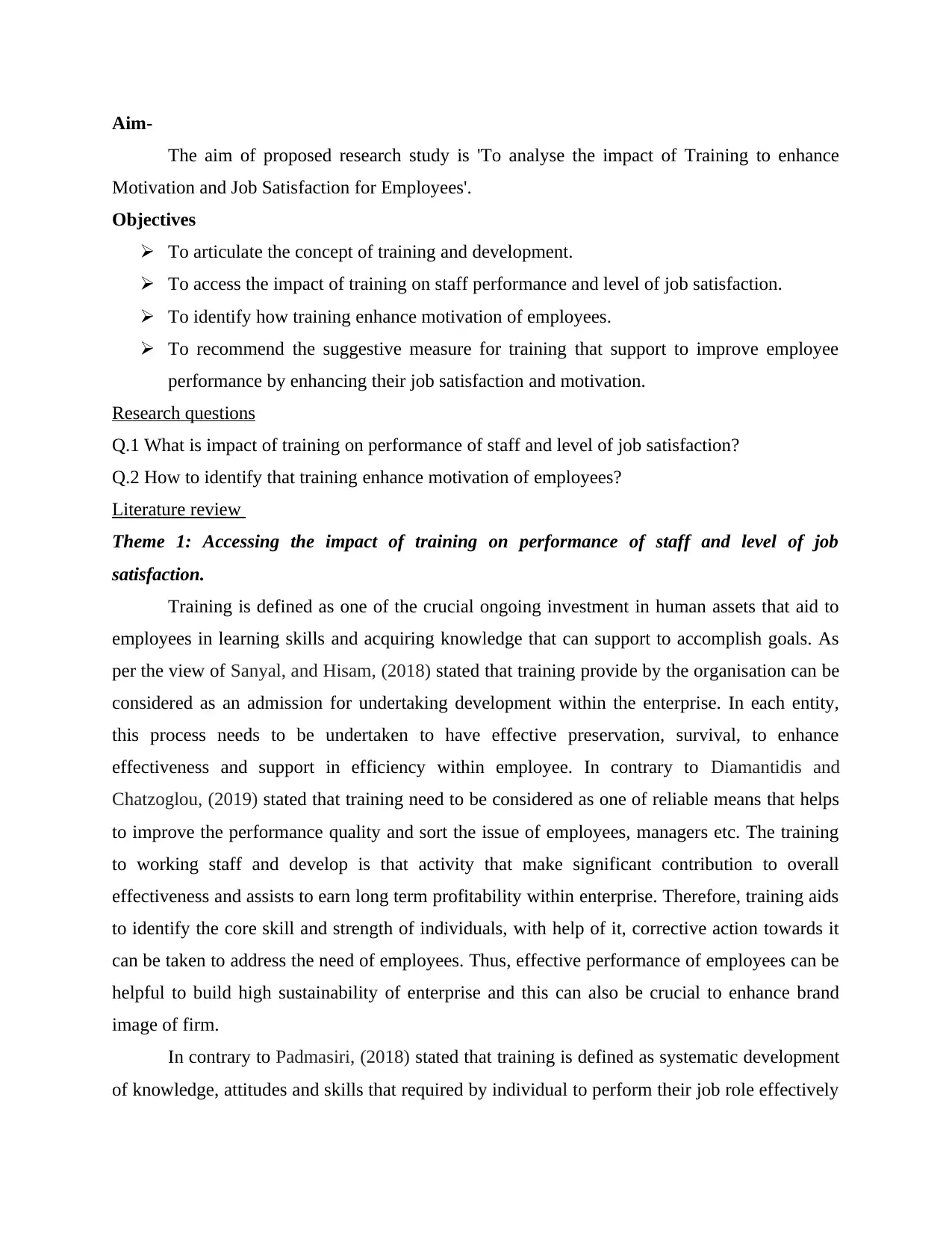
Aim-
The aim of proposed research study is 'To analyse the impact of Training to enhance
Motivation and Job Satisfaction for Employees'.
Objectives
To articulate the concept of training and development.
To access the impact of training on staff performance and level of job satisfaction.
To identify how training enhance motivation of employees.
To recommend the suggestive measure for training that support to improve employee
performance by enhancing their job satisfaction and motivation.
Research questions
Q.1 What is impact of training on performance of staff and level of job satisfaction?
Q.2 How to identify that training enhance motivation of employees?
Literature review
Theme 1: Accessing the impact of training on performance of staff and level of job
satisfaction.
Training is defined as one of the crucial ongoing investment in human assets that aid to
employees in learning skills and acquiring knowledge that can support to accomplish goals. As
per the view of Sanyal, and Hisam, (2018) stated that training provide by the organisation can be
considered as an admission for undertaking development within the enterprise. In each entity,
this process needs to be undertaken to have effective preservation, survival, to enhance
effectiveness and support in efficiency within employee. In contrary to Diamantidis and
Chatzoglou, (2019) stated that training need to be considered as one of reliable means that helps
to improve the performance quality and sort the issue of employees, managers etc. The training
to working staff and develop is that activity that make significant contribution to overall
effectiveness and assists to earn long term profitability within enterprise. Therefore, training aids
to identify the core skill and strength of individuals, with help of it, corrective action towards it
can be taken to address the need of employees. Thus, effective performance of employees can be
helpful to build high sustainability of enterprise and this can also be crucial to enhance brand
image of firm.
In contrary to Padmasiri, (2018) stated that training is defined as systematic development
of knowledge, attitudes and skills that required by individual to perform their job role effectively
The aim of proposed research study is 'To analyse the impact of Training to enhance
Motivation and Job Satisfaction for Employees'.
Objectives
To articulate the concept of training and development.
To access the impact of training on staff performance and level of job satisfaction.
To identify how training enhance motivation of employees.
To recommend the suggestive measure for training that support to improve employee
performance by enhancing their job satisfaction and motivation.
Research questions
Q.1 What is impact of training on performance of staff and level of job satisfaction?
Q.2 How to identify that training enhance motivation of employees?
Literature review
Theme 1: Accessing the impact of training on performance of staff and level of job
satisfaction.
Training is defined as one of the crucial ongoing investment in human assets that aid to
employees in learning skills and acquiring knowledge that can support to accomplish goals. As
per the view of Sanyal, and Hisam, (2018) stated that training provide by the organisation can be
considered as an admission for undertaking development within the enterprise. In each entity,
this process needs to be undertaken to have effective preservation, survival, to enhance
effectiveness and support in efficiency within employee. In contrary to Diamantidis and
Chatzoglou, (2019) stated that training need to be considered as one of reliable means that helps
to improve the performance quality and sort the issue of employees, managers etc. The training
to working staff and develop is that activity that make significant contribution to overall
effectiveness and assists to earn long term profitability within enterprise. Therefore, training aids
to identify the core skill and strength of individuals, with help of it, corrective action towards it
can be taken to address the need of employees. Thus, effective performance of employees can be
helpful to build high sustainability of enterprise and this can also be crucial to enhance brand
image of firm.
In contrary to Padmasiri, (2018) stated that training is defined as systematic development
of knowledge, attitudes and skills that required by individual to perform their job role effectively
⊘ This is a preview!⊘
Do you want full access?
Subscribe today to unlock all pages.

Trusted by 1+ million students worldwide
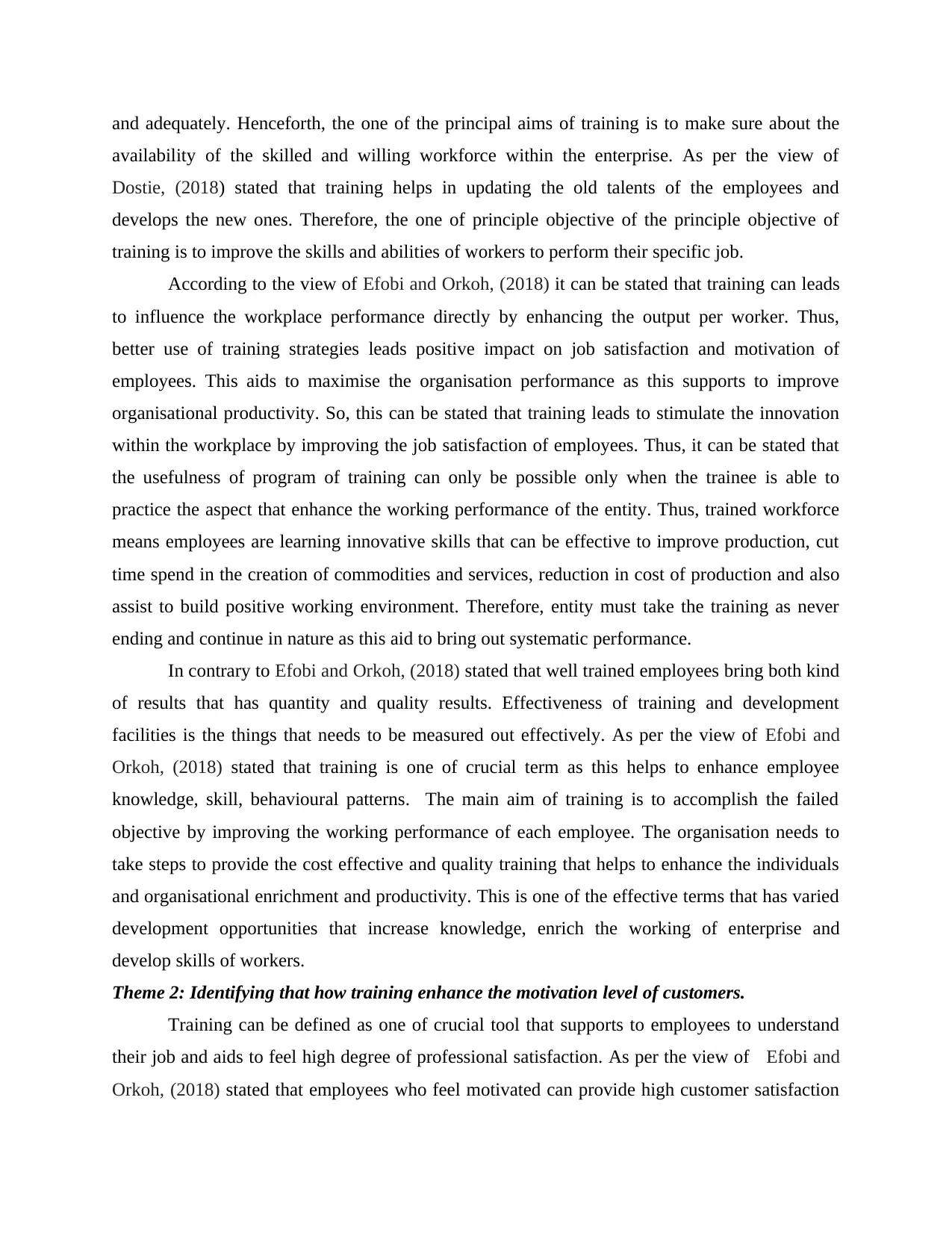
and adequately. Henceforth, the one of the principal aims of training is to make sure about the
availability of the skilled and willing workforce within the enterprise. As per the view of
Dostie, (2018) stated that training helps in updating the old talents of the employees and
develops the new ones. Therefore, the one of principle objective of the principle objective of
training is to improve the skills and abilities of workers to perform their specific job.
According to the view of Efobi and Orkoh, (2018) it can be stated that training can leads
to influence the workplace performance directly by enhancing the output per worker. Thus,
better use of training strategies leads positive impact on job satisfaction and motivation of
employees. This aids to maximise the organisation performance as this supports to improve
organisational productivity. So, this can be stated that training leads to stimulate the innovation
within the workplace by improving the job satisfaction of employees. Thus, it can be stated that
the usefulness of program of training can only be possible only when the trainee is able to
practice the aspect that enhance the working performance of the entity. Thus, trained workforce
means employees are learning innovative skills that can be effective to improve production, cut
time spend in the creation of commodities and services, reduction in cost of production and also
assist to build positive working environment. Therefore, entity must take the training as never
ending and continue in nature as this aid to bring out systematic performance.
In contrary to Efobi and Orkoh, (2018) stated that well trained employees bring both kind
of results that has quantity and quality results. Effectiveness of training and development
facilities is the things that needs to be measured out effectively. As per the view of Efobi and
Orkoh, (2018) stated that training is one of crucial term as this helps to enhance employee
knowledge, skill, behavioural patterns. The main aim of training is to accomplish the failed
objective by improving the working performance of each employee. The organisation needs to
take steps to provide the cost effective and quality training that helps to enhance the individuals
and organisational enrichment and productivity. This is one of the effective terms that has varied
development opportunities that increase knowledge, enrich the working of enterprise and
develop skills of workers.
Theme 2: Identifying that how training enhance the motivation level of customers.
Training can be defined as one of crucial tool that supports to employees to understand
their job and aids to feel high degree of professional satisfaction. As per the view of Efobi and
Orkoh, (2018) stated that employees who feel motivated can provide high customer satisfaction
availability of the skilled and willing workforce within the enterprise. As per the view of
Dostie, (2018) stated that training helps in updating the old talents of the employees and
develops the new ones. Therefore, the one of principle objective of the principle objective of
training is to improve the skills and abilities of workers to perform their specific job.
According to the view of Efobi and Orkoh, (2018) it can be stated that training can leads
to influence the workplace performance directly by enhancing the output per worker. Thus,
better use of training strategies leads positive impact on job satisfaction and motivation of
employees. This aids to maximise the organisation performance as this supports to improve
organisational productivity. So, this can be stated that training leads to stimulate the innovation
within the workplace by improving the job satisfaction of employees. Thus, it can be stated that
the usefulness of program of training can only be possible only when the trainee is able to
practice the aspect that enhance the working performance of the entity. Thus, trained workforce
means employees are learning innovative skills that can be effective to improve production, cut
time spend in the creation of commodities and services, reduction in cost of production and also
assist to build positive working environment. Therefore, entity must take the training as never
ending and continue in nature as this aid to bring out systematic performance.
In contrary to Efobi and Orkoh, (2018) stated that well trained employees bring both kind
of results that has quantity and quality results. Effectiveness of training and development
facilities is the things that needs to be measured out effectively. As per the view of Efobi and
Orkoh, (2018) stated that training is one of crucial term as this helps to enhance employee
knowledge, skill, behavioural patterns. The main aim of training is to accomplish the failed
objective by improving the working performance of each employee. The organisation needs to
take steps to provide the cost effective and quality training that helps to enhance the individuals
and organisational enrichment and productivity. This is one of the effective terms that has varied
development opportunities that increase knowledge, enrich the working of enterprise and
develop skills of workers.
Theme 2: Identifying that how training enhance the motivation level of customers.
Training can be defined as one of crucial tool that supports to employees to understand
their job and aids to feel high degree of professional satisfaction. As per the view of Efobi and
Orkoh, (2018) stated that employees who feel motivated can provide high customer satisfaction
Paraphrase This Document
Need a fresh take? Get an instant paraphrase of this document with our AI Paraphraser
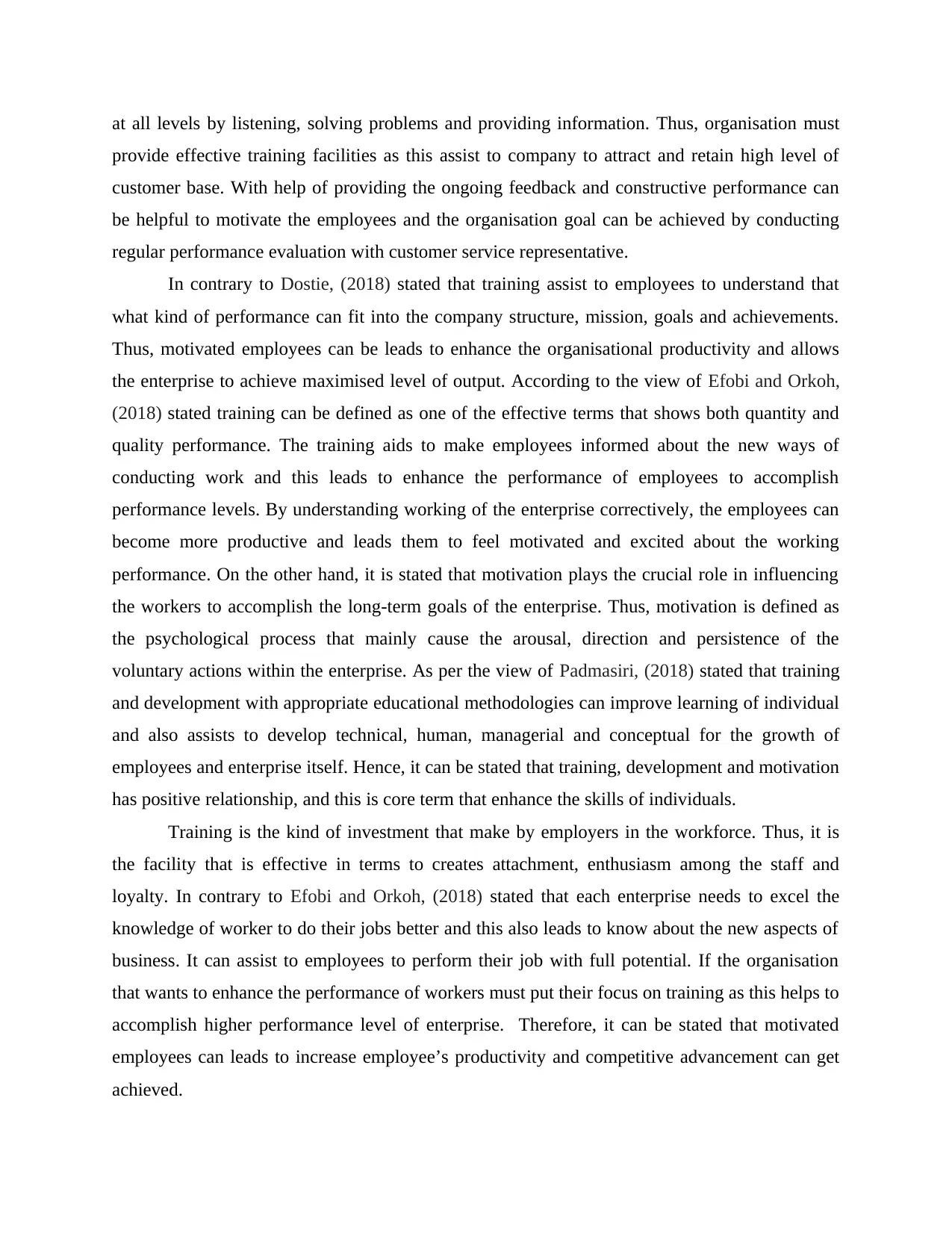
at all levels by listening, solving problems and providing information. Thus, organisation must
provide effective training facilities as this assist to company to attract and retain high level of
customer base. With help of providing the ongoing feedback and constructive performance can
be helpful to motivate the employees and the organisation goal can be achieved by conducting
regular performance evaluation with customer service representative.
In contrary to Dostie, (2018) stated that training assist to employees to understand that
what kind of performance can fit into the company structure, mission, goals and achievements.
Thus, motivated employees can be leads to enhance the organisational productivity and allows
the enterprise to achieve maximised level of output. According to the view of Efobi and Orkoh,
(2018) stated training can be defined as one of the effective terms that shows both quantity and
quality performance. The training aids to make employees informed about the new ways of
conducting work and this leads to enhance the performance of employees to accomplish
performance levels. By understanding working of the enterprise correctively, the employees can
become more productive and leads them to feel motivated and excited about the working
performance. On the other hand, it is stated that motivation plays the crucial role in influencing
the workers to accomplish the long-term goals of the enterprise. Thus, motivation is defined as
the psychological process that mainly cause the arousal, direction and persistence of the
voluntary actions within the enterprise. As per the view of Padmasiri, (2018) stated that training
and development with appropriate educational methodologies can improve learning of individual
and also assists to develop technical, human, managerial and conceptual for the growth of
employees and enterprise itself. Hence, it can be stated that training, development and motivation
has positive relationship, and this is core term that enhance the skills of individuals.
Training is the kind of investment that make by employers in the workforce. Thus, it is
the facility that is effective in terms to creates attachment, enthusiasm among the staff and
loyalty. In contrary to Efobi and Orkoh, (2018) stated that each enterprise needs to excel the
knowledge of worker to do their jobs better and this also leads to know about the new aspects of
business. It can assist to employees to perform their job with full potential. If the organisation
that wants to enhance the performance of workers must put their focus on training as this helps to
accomplish higher performance level of enterprise. Therefore, it can be stated that motivated
employees can leads to increase employee’s productivity and competitive advancement can get
achieved.
provide effective training facilities as this assist to company to attract and retain high level of
customer base. With help of providing the ongoing feedback and constructive performance can
be helpful to motivate the employees and the organisation goal can be achieved by conducting
regular performance evaluation with customer service representative.
In contrary to Dostie, (2018) stated that training assist to employees to understand that
what kind of performance can fit into the company structure, mission, goals and achievements.
Thus, motivated employees can be leads to enhance the organisational productivity and allows
the enterprise to achieve maximised level of output. According to the view of Efobi and Orkoh,
(2018) stated training can be defined as one of the effective terms that shows both quantity and
quality performance. The training aids to make employees informed about the new ways of
conducting work and this leads to enhance the performance of employees to accomplish
performance levels. By understanding working of the enterprise correctively, the employees can
become more productive and leads them to feel motivated and excited about the working
performance. On the other hand, it is stated that motivation plays the crucial role in influencing
the workers to accomplish the long-term goals of the enterprise. Thus, motivation is defined as
the psychological process that mainly cause the arousal, direction and persistence of the
voluntary actions within the enterprise. As per the view of Padmasiri, (2018) stated that training
and development with appropriate educational methodologies can improve learning of individual
and also assists to develop technical, human, managerial and conceptual for the growth of
employees and enterprise itself. Hence, it can be stated that training, development and motivation
has positive relationship, and this is core term that enhance the skills of individuals.
Training is the kind of investment that make by employers in the workforce. Thus, it is
the facility that is effective in terms to creates attachment, enthusiasm among the staff and
loyalty. In contrary to Efobi and Orkoh, (2018) stated that each enterprise needs to excel the
knowledge of worker to do their jobs better and this also leads to know about the new aspects of
business. It can assist to employees to perform their job with full potential. If the organisation
that wants to enhance the performance of workers must put their focus on training as this helps to
accomplish higher performance level of enterprise. Therefore, it can be stated that motivated
employees can leads to increase employee’s productivity and competitive advancement can get
achieved.
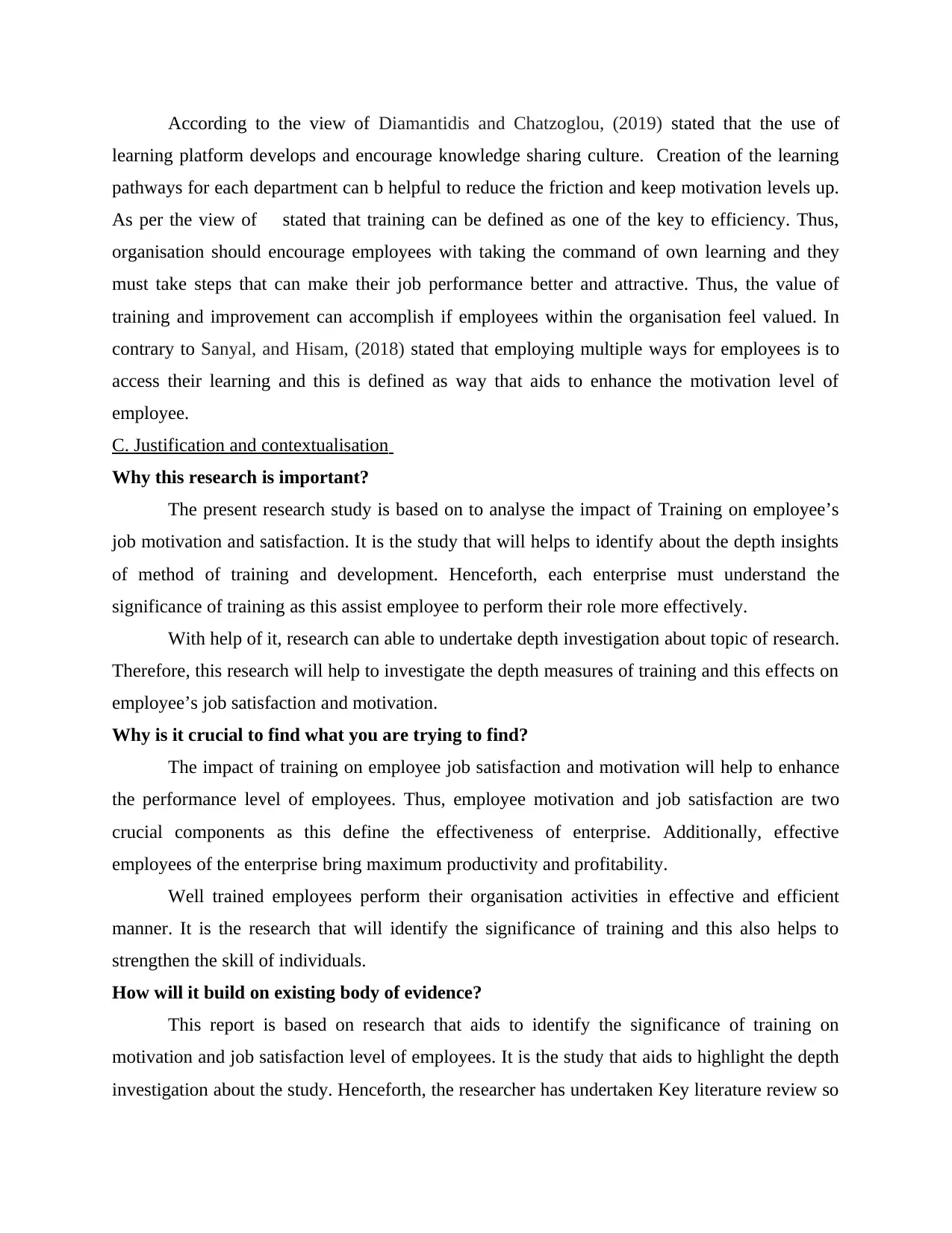
According to the view of Diamantidis and Chatzoglou, (2019) stated that the use of
learning platform develops and encourage knowledge sharing culture. Creation of the learning
pathways for each department can b helpful to reduce the friction and keep motivation levels up.
As per the view of stated that training can be defined as one of the key to efficiency. Thus,
organisation should encourage employees with taking the command of own learning and they
must take steps that can make their job performance better and attractive. Thus, the value of
training and improvement can accomplish if employees within the organisation feel valued. In
contrary to Sanyal, and Hisam, (2018) stated that employing multiple ways for employees is to
access their learning and this is defined as way that aids to enhance the motivation level of
employee.
C. Justification and contextualisation
Why this research is important?
The present research study is based on to analyse the impact of Training on employee’s
job motivation and satisfaction. It is the study that will helps to identify about the depth insights
of method of training and development. Henceforth, each enterprise must understand the
significance of training as this assist employee to perform their role more effectively.
With help of it, research can able to undertake depth investigation about topic of research.
Therefore, this research will help to investigate the depth measures of training and this effects on
employee’s job satisfaction and motivation.
Why is it crucial to find what you are trying to find?
The impact of training on employee job satisfaction and motivation will help to enhance
the performance level of employees. Thus, employee motivation and job satisfaction are two
crucial components as this define the effectiveness of enterprise. Additionally, effective
employees of the enterprise bring maximum productivity and profitability.
Well trained employees perform their organisation activities in effective and efficient
manner. It is the research that will identify the significance of training and this also helps to
strengthen the skill of individuals.
How will it build on existing body of evidence?
This report is based on research that aids to identify the significance of training on
motivation and job satisfaction level of employees. It is the study that aids to highlight the depth
investigation about the study. Henceforth, the researcher has undertaken Key literature review so
learning platform develops and encourage knowledge sharing culture. Creation of the learning
pathways for each department can b helpful to reduce the friction and keep motivation levels up.
As per the view of stated that training can be defined as one of the key to efficiency. Thus,
organisation should encourage employees with taking the command of own learning and they
must take steps that can make their job performance better and attractive. Thus, the value of
training and improvement can accomplish if employees within the organisation feel valued. In
contrary to Sanyal, and Hisam, (2018) stated that employing multiple ways for employees is to
access their learning and this is defined as way that aids to enhance the motivation level of
employee.
C. Justification and contextualisation
Why this research is important?
The present research study is based on to analyse the impact of Training on employee’s
job motivation and satisfaction. It is the study that will helps to identify about the depth insights
of method of training and development. Henceforth, each enterprise must understand the
significance of training as this assist employee to perform their role more effectively.
With help of it, research can able to undertake depth investigation about topic of research.
Therefore, this research will help to investigate the depth measures of training and this effects on
employee’s job satisfaction and motivation.
Why is it crucial to find what you are trying to find?
The impact of training on employee job satisfaction and motivation will help to enhance
the performance level of employees. Thus, employee motivation and job satisfaction are two
crucial components as this define the effectiveness of enterprise. Additionally, effective
employees of the enterprise bring maximum productivity and profitability.
Well trained employees perform their organisation activities in effective and efficient
manner. It is the research that will identify the significance of training and this also helps to
strengthen the skill of individuals.
How will it build on existing body of evidence?
This report is based on research that aids to identify the significance of training on
motivation and job satisfaction level of employees. It is the study that aids to highlight the depth
investigation about the study. Henceforth, the researcher has undertaken Key literature review so
⊘ This is a preview!⊘
Do you want full access?
Subscribe today to unlock all pages.

Trusted by 1+ million students worldwide

that significance about the use of training and impact on performance level of employees has
been identified. However, the information in this report is intended to assist organisation
decision makes to make them realise about the significance of training.
Is it timely? does it respond to existing need? What makes it so?
The present research that has undertaken by research has completed on the given
deadline. This research is very significant as this aids to evaluate the importance of training on
performance of employees. Additionally, this research has systematically determined the
significance of training and its usefulness on employee motivation and satisfaction towards job.
By collecting the research effectively, the whole things can be conducted in better and
appropriate manner.
Research methodology
This is defined as specific procedure or technique that is very effective in term to
investigate, select and analyse the information about the topic. Therefore, this is that section that
allows the reader to critically evaluate the overall reliability and validity of research. It is useful
to collect the information and data with aim of making business decision. Henceforth, research
methodologies classified into category as-
Research type-
It is defined as systematic collection of data and information and also can defined as
analysis for advancement of knowledge about particular topic. Thus, research classified into
categories as qualitative and quantitative. Therefore, qualitative research can be termed out as
method that aids to collect non-numerical data. Thus, quantitative data defines the phenomena by
gathering numerical data that can be analysed with use of mathematically based methods. For the
present research study, the researcher will select the qualitative analyse with use of questionnaire
technique to analyse the impact of training on motivation and job satisfaction of employees.
Research approach-
It is termed out as plan and procedure that is inclusive of broad assumption to conduct
detailed method of data analysis, data collection and interpretation. Thus, research approach
classified into categories as inductive and deductive. The inductive approach termed out as
theories and observation that are proposed towards the end of research process. On the other
hand, deductive approach mainly concerned with developing hypothesis that is based on existing
theory. In order to undertake the present research, the researcher will have the use of inductive
been identified. However, the information in this report is intended to assist organisation
decision makes to make them realise about the significance of training.
Is it timely? does it respond to existing need? What makes it so?
The present research that has undertaken by research has completed on the given
deadline. This research is very significant as this aids to evaluate the importance of training on
performance of employees. Additionally, this research has systematically determined the
significance of training and its usefulness on employee motivation and satisfaction towards job.
By collecting the research effectively, the whole things can be conducted in better and
appropriate manner.
Research methodology
This is defined as specific procedure or technique that is very effective in term to
investigate, select and analyse the information about the topic. Therefore, this is that section that
allows the reader to critically evaluate the overall reliability and validity of research. It is useful
to collect the information and data with aim of making business decision. Henceforth, research
methodologies classified into category as-
Research type-
It is defined as systematic collection of data and information and also can defined as
analysis for advancement of knowledge about particular topic. Thus, research classified into
categories as qualitative and quantitative. Therefore, qualitative research can be termed out as
method that aids to collect non-numerical data. Thus, quantitative data defines the phenomena by
gathering numerical data that can be analysed with use of mathematically based methods. For the
present research study, the researcher will select the qualitative analyse with use of questionnaire
technique to analyse the impact of training on motivation and job satisfaction of employees.
Research approach-
It is termed out as plan and procedure that is inclusive of broad assumption to conduct
detailed method of data analysis, data collection and interpretation. Thus, research approach
classified into categories as inductive and deductive. The inductive approach termed out as
theories and observation that are proposed towards the end of research process. On the other
hand, deductive approach mainly concerned with developing hypothesis that is based on existing
theory. In order to undertake the present research, the researcher will have the use of inductive
Paraphrase This Document
Need a fresh take? Get an instant paraphrase of this document with our AI Paraphraser
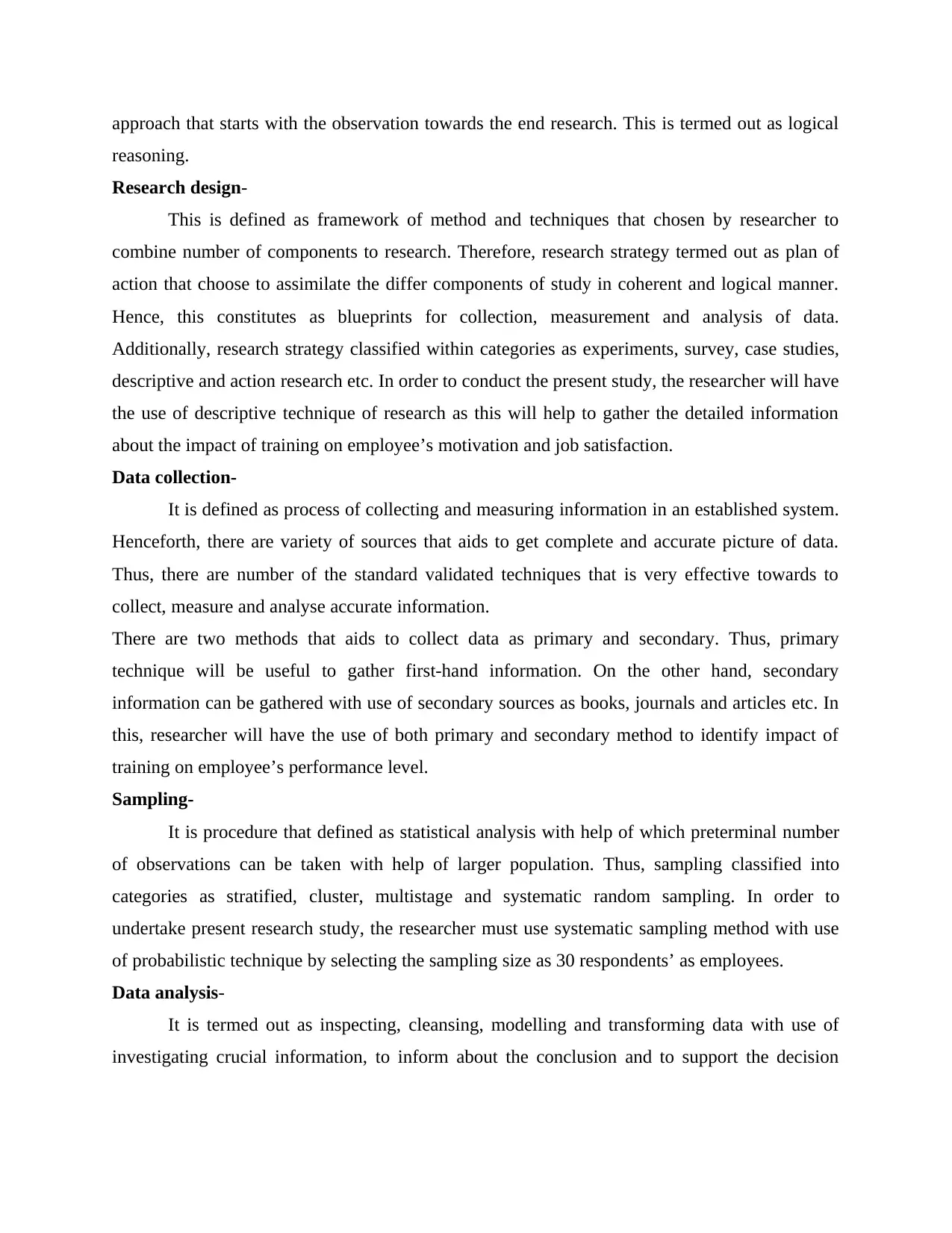
approach that starts with the observation towards the end research. This is termed out as logical
reasoning.
Research design-
This is defined as framework of method and techniques that chosen by researcher to
combine number of components to research. Therefore, research strategy termed out as plan of
action that choose to assimilate the differ components of study in coherent and logical manner.
Hence, this constitutes as blueprints for collection, measurement and analysis of data.
Additionally, research strategy classified within categories as experiments, survey, case studies,
descriptive and action research etc. In order to conduct the present study, the researcher will have
the use of descriptive technique of research as this will help to gather the detailed information
about the impact of training on employee’s motivation and job satisfaction.
Data collection-
It is defined as process of collecting and measuring information in an established system.
Henceforth, there are variety of sources that aids to get complete and accurate picture of data.
Thus, there are number of the standard validated techniques that is very effective towards to
collect, measure and analyse accurate information.
There are two methods that aids to collect data as primary and secondary. Thus, primary
technique will be useful to gather first-hand information. On the other hand, secondary
information can be gathered with use of secondary sources as books, journals and articles etc. In
this, researcher will have the use of both primary and secondary method to identify impact of
training on employee’s performance level.
Sampling-
It is procedure that defined as statistical analysis with help of which preterminal number
of observations can be taken with help of larger population. Thus, sampling classified into
categories as stratified, cluster, multistage and systematic random sampling. In order to
undertake present research study, the researcher must use systematic sampling method with use
of probabilistic technique by selecting the sampling size as 30 respondents’ as employees.
Data analysis-
It is termed out as inspecting, cleansing, modelling and transforming data with use of
investigating crucial information, to inform about the conclusion and to support the decision
reasoning.
Research design-
This is defined as framework of method and techniques that chosen by researcher to
combine number of components to research. Therefore, research strategy termed out as plan of
action that choose to assimilate the differ components of study in coherent and logical manner.
Hence, this constitutes as blueprints for collection, measurement and analysis of data.
Additionally, research strategy classified within categories as experiments, survey, case studies,
descriptive and action research etc. In order to conduct the present study, the researcher will have
the use of descriptive technique of research as this will help to gather the detailed information
about the impact of training on employee’s motivation and job satisfaction.
Data collection-
It is defined as process of collecting and measuring information in an established system.
Henceforth, there are variety of sources that aids to get complete and accurate picture of data.
Thus, there are number of the standard validated techniques that is very effective towards to
collect, measure and analyse accurate information.
There are two methods that aids to collect data as primary and secondary. Thus, primary
technique will be useful to gather first-hand information. On the other hand, secondary
information can be gathered with use of secondary sources as books, journals and articles etc. In
this, researcher will have the use of both primary and secondary method to identify impact of
training on employee’s performance level.
Sampling-
It is procedure that defined as statistical analysis with help of which preterminal number
of observations can be taken with help of larger population. Thus, sampling classified into
categories as stratified, cluster, multistage and systematic random sampling. In order to
undertake present research study, the researcher must use systematic sampling method with use
of probabilistic technique by selecting the sampling size as 30 respondents’ as employees.
Data analysis-
It is termed out as inspecting, cleansing, modelling and transforming data with use of
investigating crucial information, to inform about the conclusion and to support the decision

making. This is one of effective method in terms to undertaking business decision. In this, data
will be collected with use of thematic analysis so that detailed information can be gathered.
Ethical consideration-
It is one of the most crucial part of research. This is an accumulation of values and
principles that will address the ethical perspective of conducting research systematically. Thus,
researcher must have informed consent before disclosing any information relate with research
data.
Limitation-
This is crucial to understand the research findings and interpreting the validity of research.
Henceforth, the limitation of study defined as those characteristics of design or methodology that
affected or influenced with the application and interpretation of research study. Therefore, this is
crucial to shortcomings of research study and will be helpful to define about the finding of
research.
CONCLUSION
From the above report it can be summarized that training is one of crucial tool that assist
to employees to perform their work effectively. Thus, study is based on to determine the impact
of training on job satisfaction and motivation of employees. Furthermore, report has outlined the
aim and objective based on give topic, justification and conclusion has been made in term to
evaluate the findings of research. Lastly, research methodologies have defined systematically to
choose method to undertake the study in detailed manner.
will be collected with use of thematic analysis so that detailed information can be gathered.
Ethical consideration-
It is one of the most crucial part of research. This is an accumulation of values and
principles that will address the ethical perspective of conducting research systematically. Thus,
researcher must have informed consent before disclosing any information relate with research
data.
Limitation-
This is crucial to understand the research findings and interpreting the validity of research.
Henceforth, the limitation of study defined as those characteristics of design or methodology that
affected or influenced with the application and interpretation of research study. Therefore, this is
crucial to shortcomings of research study and will be helpful to define about the finding of
research.
CONCLUSION
From the above report it can be summarized that training is one of crucial tool that assist
to employees to perform their work effectively. Thus, study is based on to determine the impact
of training on job satisfaction and motivation of employees. Furthermore, report has outlined the
aim and objective based on give topic, justification and conclusion has been made in term to
evaluate the findings of research. Lastly, research methodologies have defined systematically to
choose method to undertake the study in detailed manner.
⊘ This is a preview!⊘
Do you want full access?
Subscribe today to unlock all pages.

Trusted by 1+ million students worldwide
1 out of 38
Related Documents
Your All-in-One AI-Powered Toolkit for Academic Success.
+13062052269
info@desklib.com
Available 24*7 on WhatsApp / Email
![[object Object]](/_next/static/media/star-bottom.7253800d.svg)
Unlock your academic potential
Copyright © 2020–2025 A2Z Services. All Rights Reserved. Developed and managed by ZUCOL.





